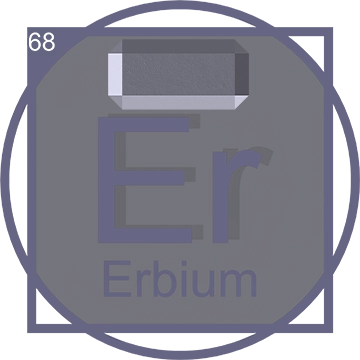Ytterbium (Yb): Insights into Its Discovery, Properties, and Applications
Ytterbium, with the chemical symbol Yb, is one of the lesser-known yet fascinating rare earth elements. This detailed guide delves into the discovery of Ytterbium, its chemical properties, and its vital role in the periodic table, as well as its broad spectrum of applications in science and technology.
Discovery of Ytterbium

Ytterbium was discovered by the Swiss chemist Jean Charles Galissard de Marignac in 1878. He identified it in the mineral gadolinite from Ytterby, a village in Sweden which has given its name to ytterbium along with other rare earth elements. Marignac initially named the new element "ytterbia," after the mineral from which it was extracted. It was later named Ytterbium when the pure element was isolated by Georges Urbain in 1907, demonstrating its distinct properties separate from other elements previously thought to be identical.
Ytterbium in the Periodic Table
Ytterbium is part of the lanthanide series, commonly referred to as the rare earth metals. It is positioned under element 70 in the periodic table, with a typical +3 oxidation state, although it also uniquely exhibits a +2 state. This positioning reflects its metallic characteristics and its behavior which is typical of most lanthanides, contributing to its specific uses in various applications.
Physical and Chemical Properties of Pure Ytterbium

Pure Ytterbium is a soft, malleable, and ductile metal known for its bright silvery luster when freshly cut. This metal slowly tarnishes in air and reacts with water, releasing hydrogen gas. Although relatively stable, pure Ytterbium can be dissolved by mineral acids, during which it releases hydrogen and forms Ytterbium (III) compounds. Notably, Ytterbium has a relatively low melting point of 824°C and boiling point of 1196°C compared to other rare earth elements. These characteristics influence its specific handling and storage requirements, especially in applications requiring high purity and stability.
Mining the Element Ytterbium

Mining ytterbium often involves extracting it from minerals where it co-occurs with other rare earth elements. Commonly associated elements include erbium, dysprosium, and holmium. These elements are typically found together in rare earth minerals such as xenotime and euxenite. The extraction of ytterbium is crucial for its various applications in electronics and materials science, where its properties are highly valued.
Significant mining locations for ytterbium and other rare earth elements include the Bayan Obo mine in China, which is one of the world's largest sources of rare earth minerals. In the United States, the Mountain Pass mine in California is another key site for the extraction of ytterbium along with other rare earth elements. These mining sites are essential for supplying the raw materials needed for numerous high-tech industries.
Applications of Ytterbium in Technology
Ytterbium Infrared Lasers

Ytterbium ions are utilized as dopants in solid-state lasers to generate infrared wavelengths, offering high efficiency and robust performance. These Ytterbium-doped materials are renowned for their reliable operation and minimal heat generation, making them ideal for precision tasks. They are extensively used in industrial applications such as cutting and engraving, where their ability to deliver precise and clean cuts is highly valued. Additionally, these lasers play a crucial role in medical procedures, offering non-invasive options for surgeries and other treatments. In the field of telecommunications, Ytterbium-doped lasers enhance signal quality and increase the bandwidth of fiber optic systems, facilitating faster and more secure communications.
Ytterbium Material Enhancements
Ytterbium, when added to stainless steel, improves its grain refinement and strength. This application is crucial in creating high-strength structural materials that are lightweight yet capable of withstanding extreme conditions.
Nuclear Physics in Ytterbium

Ytterbium has several isotopes that are of significant interest in the field of nuclear medicine and research. Isotopes such as Ytterbium-169 are notably used in portable X-ray machines, which benefit from its compact and efficient radioactive properties. Additionally, Ytterbium isotopes play a crucial role in various diagnostic procedures and therapeutic applications. The gamma rays emitted by Ytterbium-169, for instance, are ideal for precise imaging techniques, enhancing the accuracy of internal diagnostics. Moreover, the properties of Ytterbium isotopes are being explored for their potential use in targeted radiation therapy, which aims to treat cancerous tissues without affecting the surrounding healthy cells.
Ytterbium Magnetometers

Ytterbium is utilized in the development of highly sensitive magnetometers that are capable of precisely measuring magnetic fields. These advanced devices play a crucial role in various applications, particularly in geophysical surveys where they are employed to detect hidden mineral deposits beneath the earth's surface, providing essential data for mining and exploration industries. Additionally, Ytterbium magnetometers are integral to security systems, where their sensitivity allows for the effective monitoring of unauthorized access, enhancing security measures in sensitive areas. Their reliability and precision also make them suitable for scientific research, where accurate magnetic field measurements are necessary.
The Future of Ytterbium

As technology evolves, so does the potential for Ytterbium. Its properties suggest more innovative uses in the future, particularly in areas requiring materials that are efficient at absorbing X-rays or as part of advanced optical equipment. Ongoing research aims to unlock further capabilities of Ytterbium in technology and industrial applications, potentially increasing its demand in global markets.
In this visionary depiction set a century into the future, we explore the control room of a sophisticated spaceship, meticulously designed to harness the advanced capabilities of Ytterbium Magnetometers security systems. The room is outfitted with expansive digital monitors that provide real-time surveillance of critical ship sections, including a state-of-the-art cancer treatment facility and the bustling engineer room. Each monitor displays detailed views, ensuring comprehensive security and operational oversight. The futuristic control panels and interactive displays highlight the ship's reliance on cutting-edge Ytterbium technology, enhancing both security and efficiency. This scene embodies the pinnacle of future space exploration technology, where medical and engineering advancements converge seamlessly in the quest for interstellar travel.













